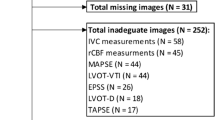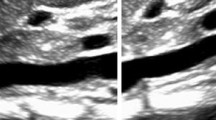Abstract
The purpose of this study is to compare Near Infrared Spectroscopy (NIRS) thenar eminence parameters obtained with 2 different devices from the same manufacturer (InSpectra Models 325 and 650, Hutchinson Tech, Min USA), and 2 different probes (15 vs. 25 mm spacing), in healthy volunteers (HV) and ICU patients. Prospective, observational study in ICU setting. Simultaneous, cross over NIRS inter-device comparison and comparison between different probes (25 vs. 15 mm spacing) were done at baseline and during vascular occlusion tests (VOTs). Forty patients (19 septic shock, 21 trauma), and 29 HV were included. NIRS inter-device comparison showed similar baseline StO2 values in HV and patients. The VOT result were significantly different for minimal StO2 value reached during VOT (StO2min) (intraclass concordance coefficient (ICC) = 0.18), the occlusion slope (ICC = 0.16) and the reperfusion slope (StO2reperf) (ICC = 0.26). The probe comparison was also significantly different for VOT parameters (StO2min (ICC = 0.43), occlusion (ICC = 0.50) and StO2reperf (ICC = 0.48). The low concordance, poor agreement and large bias (ICC and Bland & Altman) observed, were related both to the device used and the probe spacing. StO2 data obtained with NIRS model 650 and 15 mm probe differ from values obtained with the previous device (325 and probe spacing 25 or 15 mm). This difference is not related to the population tested, but to the device and probe spacing. As a consequence, despite similar trends for variations between HV and patients during VOT, threshold and predictive values for outcome should be revisited with the new device before the acceptance for routine clinical use.



Similar content being viewed by others
References
Crookes BA, Cohn SM, Burton EA, Nelson J, Proctor KG. Noninvasive muscle oxygenation to guide fluid resuscitation after traumatic shock. Surgery. 2004;135:662–70.
Cohn SM, Nathens AB, Moore FA, Rhee P, Puyana JC, Moore EE, Beilman GJ. Tissue oxygen saturation predicts the development of organ dysfunction during traumatic shock resuscitation. J Trauma. 2007;62:44–54. (discussion 54-45).
Heyer L, Mebazaa A, Gayat E, Resche-Rigon M, Rabuel C, Rezlan E, Lukascewicz AC, Madadaki C, Pirracchio R, Schurando P, Morel O, Fargeaudou Y, Payen D. Cardiac troponin and skeletal muscle oxygenation in severe post-partum haemorrhage. Crit Care. 2009;13(Suppl 5):S8.
Skarda DE, Mulier KE, Myers DE, Taylor JH, Beilman GJ. Dynamic near-infrared spectroscopy measurements in patients with severe sepsis. Shock. 2007;27:348–53.
Doerschug KC, Delsing AS, Schmidt GA, Haynes WG. Impairments in microvascular reactivity are related to organ failure in human sepsis. Am J Physiol Heart Circ Physiol. 2007;293:H1065–71.
Pareznik R, Knezevic R, Voga G, Podbregar M. Changes in muscle tissue oxygenation during stagnant ischemia in septic patients. Intensive Care Med. 2006;32:87–92.
De Blasi RA, Palmisani S, Alampi D, Mercieri M, Romano R, Collini S, Pinto G. Microvascular dysfunction and skeletal muscle oxygenation assessed by phase-modulation near-infrared spectroscopy in patients with septic shock. Intensive Care Med. 2005;31:1661–8.
Uilkema RJ, Groeneveld AB. Correlates of thenar near-infrared spectroscopy-derived tissue O2 saturation after cardiac surgery. Interact Cardiovasc Thorac Surg. 2007;6:265–9.
Podbregar M, Mozina H. Skeletal muscle oxygen saturation does not estimate mixed venous oxygen saturation in patients with severe left heart failure and additional severe sepsis or septic shock. Crit Care. 2007;11:R6.
Taylor JH, Mulier KE, Myers DE, Beilman GJ. Use of near-infrared spectroscopy in early determination of irreversible hemorrhagic shock. J Trauma. 2005;58:1119–25.
Moore FA, Nelson T, McKinley BA, Moore EE, Nathens AB, Rhee P, Puyana JC, Beilman GJ, Cohn SM. Massive transfusion in trauma patients: tissue hemoglobin oxygen saturation predicts poor outcome. J Trauma. 2008;64:1010–23.
Gomez H, Torres A, Polanco P, Kim HK, Zenker S, Puyana JC, Pinsky MR. Use of non-invasive NIRS during a vascular occlusion test to assess dynamic tissue O(2) saturation response. Intensive Care Med. 2008;34:1600–7.
Creteur J, Carollo T, Soldati G, Buchele G, De Backer D, Vincent JL. The prognostic value of muscle StO2 in septic patients. Intensive Care Med. 2007;33:1549–56.
Hampson NB, Piantadosi CA. Near infrared monitoring of human skeletal muscle oxygenation during forearm ischemia. J Appl Physiol. 1988;64:2449–57.
Mancini DM, Bolinger L, Li H, Kendrick K, Chance B, Wilson JR. Validation of near-infrared spectroscopy in humans. J Appl Physiol. 1994;77:2740–7.
Creteur J. Muscle StO2 in critically ill patients. Curr Opin Crit Care. 2008;14:361–6.
Neviere R, Mathieu D, Chagnon JL, Lebleu N, Millien JP, Wattel F. Skeletal muscle microvascular blood flow and oxygen transport in patients with severe sepsis. Am J Respir Crit Care Med. 1996;153:191–5.
Payen D, Luengo C, Heyer L, Resche-Rigon M, Kerever S, Damoisel C, Losser MR. Is thenar tissue hemoglobin oxygen saturation in septic shock related to macrohemodynamic variables and outcome? Crit Care. 2009;13(Suppl 5):S6.
Levy MM, Fink MP, Marshall JC, Abraham E, Angus D, Cook D, Cohen J, Opal SM, Vincent JL, Ramsay G. 2001 SCCM/ESICM/ACCP/ATS/SIS international sepsis definitions conference. Crit Care Med. 2003;31:1250–6.
Myers DE, Anderson LD, Seifert RP, Ortner JP, Cooper CE, Beilman GJ, Mowlem JD. Noninvasive method for measuring local hemoglobin oxygen saturation in tissue using wide gap second derivative near-infrared spectroscopy. J Biomed Opt. 2005;10:034017.
Scheeren TW, Schober P, Schwarte LA. Monitoring tissue oxygenation by near infrared spectroscopy (NIRS): background and current applications. J Clin Monit Comput. 2012;26:279–87.
Ward KR, Ivatury RR, Barbee RW, Terner J, Pittman R, Filho IP, Spiess B. Near infrared spectroscopy for evaluation of the trauma patient: a technology review. Resuscitation. 2006;68:27–44.
Bezemer R, Karemaker JM, Klijn E, Martin D, Mitchell K, Grocott M, Heger M, Ince C. Simultaneous multi-depth assessment of tissue oxygen saturation in thenar and forearm using near-infrared spectroscopy during a simple cardiovascular challenge. Crit Care. 2009;13(Suppl 5):S5.
Bezemer R, Lima A, Myers D, Klijn E, Heger M, Goedhart PT, Bakker J, Ince C. Assessment of tissue oxygen saturation during a vascular occlusion test using near-infrared spectroscopy: the role of probe spacing and measurement site studied in healthy volunteers. Crit Care. 2009;13(Suppl 5):S4.
Soller BR, Ryan KL, Rickards CA, Cooke WH, Yang Y, Soyemi OO, Crookes BA, Heard SO, Convertino VA. Oxygen saturation determined from deep muscle, not thenar tissue, is an early indicator of central hypovolemia in humans. Crit Care Med. 2008;36:176–82.
Gomez H, Mesquida J, Simon P, Kim HK, Puyana JC, Ince C, Pinsky MR. Characterization of tissue oxygen saturation and the vascular occlusion test: influence of measurement sites, probe sizes and deflation thresholds. Crit Care. 2009;13(Suppl 5):S3.
Colin G, Nardi O, Polito A, Aboab J, Maxime V, Clair B, Friedman D, Orlikowski D, Sharshar T, Annane D. Masseter tissue oxygen saturation predicts normal central venous oxygen saturation during early goal-directed therapy and predicts mortality in patients with severe sepsis. Crit Care Med. 2012;40:435–40.
Weil MH, Shubin H. Proposed reclassification of shock states with special reference to distributive defects. Adv Exp Med Biol. 1971;23:13–23.
De Backer D, Creteur J, Preiser JC, Dubois MJ, Vincent JL. Microvascular blood flow is altered in patients with sepsis. Am J Respir Crit Care Med. 2002;166:98–104.
Spronk PE, Zandstra DF, Ince C. Bench-to-bedside review: sepsis is a disease of the microcirculation. Crit Care. 2004;8:462–8.
Elbers PW, Ince C. Mechanisms of critical illness–classifying microcirculatory flow abnormalities in distributive shock. Crit Care. 2006;10:221.
Lee J, Koh D, Ong CN. Statistical evaluation of agreement between two methods for measuring a quantitative variable. Comput Biol Med. 1989;19:61–70.
Bland JM, Altman DG. Statistical methods for assessing agreement between two methods of clinical measurement. Lancet. 1986;1:307–10.
Bland JM, Altman DG. Measurement error and correlation coefficients. BMJ. 1996;313:41–2.
R Development Core Team. R: a language and environment for statistical computing; from R Foundation for Statistical Computing, Vienna, Austria. 2012. http://www.R-project.org/.
Author information
Authors and Affiliations
Corresponding author
Rights and permissions
About this article
Cite this article
Luengo, C., Resche-Rigon, M., Damoisel, C. et al. Comparison of two different generations of “NIRS” devices and transducers in healthy volunteers and ICU patients. J Clin Monit Comput 27, 71–79 (2013). https://doi.org/10.1007/s10877-012-9400-y
Received:
Accepted:
Published:
Issue Date:
DOI: https://doi.org/10.1007/s10877-012-9400-y




